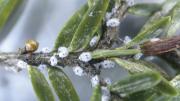The dark but delicate beauty of hemlocks has inspired writers for centuries—Henry David Thoreau, Emily Dickinson, Ernest Hemingway, and Robert Frost among them. David R. Foster, senior lecturer on biology and director of the Harvard Forest, recently joined that list with the publication of his new book, Hemlock: A Forest Giant on the Edge (Yale). His message is melancholy: within the next 10 years, hemlocks in forests across the United States are projected to die off completely.
A tiny insect, the woolly adelgid, which originated in Asia, is killing these giant evergreens. It’s slowly been doing so for nearly 60 years, Foster says, and at last, the hemlock population has reached a critical point. There’s nothing science can do to stop it. The adelgid “basically sucks the sap out of the tree and deprives the tree of nutrients and sugar for energy—that’s why it’s a slow process,” he explains. “It’s not something that comes in and eats all the needles and just kills the tree outright—it takes a while because it’s basically competing with the tree for the tree’s own resources.”
It seems ironic that these massive trees could be laid low by something so small. Hemlocks can grow more than 150 feet tall, with large canopies that shade forests and streams. The woolly adelgid measures just three millimeters long.
In A Forest Giant, Foster and his coauthors (eight Harvard Forest researchers) reflect in essays on the eastern hemlock’s unique value to human culture, ecosystems, and scientific research. They also document the tree’s demise, turning the tragedy into a major scientific study. “This is a fundamental research question in all of science: what’s the role, what’s the importance, of an individual species?” Foster points out. “Since the hemlock is such an unusual species, we expect, and the results certainly seem to show, that it plays a unique role, so its loss has a major impact on the way the whole ecosystem operates.”
Although Foster says the loss of trees from insects or disease, especially in conditions of climate change, is a natural part of many ecosystems, scientists can learn a great deal from “foundation species” like hemlocks that influence all the surrounding species in their ecosystem, shaping and controlling conditions from the bottom up. In this case, the hemlock has an extraordinary capacity to absorb sunlight: in a thick hemlock forest, only about 1 percent of sunlight reaches the ground. The deep shade the hemlock creates “is tolerated by few other plant species and creates cool, damp conditions,” Foster explains. “Thus hemlock creates an environment that is advantageous to some [species]—salamanders, brook trout in cool streams, a handful of other plants, including young hemlocks—and that is quite distinct from that of other forests.”
Hemlocks have had an unusual history—in the eastern United States they became abundant after the glaciers melted and forests recovered, about 10,000 years ago. The species was prevalent until about 5,000 years ago, when it essentially disappeared, most likely due to a combination of climate change and the outbreak of some type of insect or pathogen, Foster says. The trees then recovered—but not, measured in geological time, for long. “They were really hit at the time of European settlement by deforestation, farming, and so on,” he continues. In modern times, they staged another comeback and were “actually poised to become an increasingly big part of the landscape. When I arrived at Harvard in 1983, there was this long history of studying hemlock because of its important role, so I simply picked that up as a very compelling tree and as a very compelling subject for study. The Arnold Arboretum had a beautiful old forest of hemlock, called Hemlock Hill, and we started studying that about 10 years ago.”
Meanwhile, the woolly adelgid had arrived in the Southeast in the 1950s. It began spreading north in the mid 1970s, arriving in New England in the early 1980s, according to Peter Del Tredici, senior research scientist at the Arboretum, where adelgids have already killed hundreds of trees on Hemlock Hill. The insect is now present through an entire range of hemlocks, from North Carolina to southern Vermont, southern New Hampshire, and southern Maine.
Foster and other Harvard researchers expect to spend the next few decades studying the ripple effects of the hemlocks’ deaths, including possible changes in the planet’s carbon-dioxide levels. “This is a study that will go on for probably the next 20 years, before hemlocks completely die out in forest settings. Then it’ll be a hundred years before the forests fully recover” from the loss of the species, he says.
As a species, at least, the hemlock will not die: individual specimens can be sprayed with an agent that will kill the insect, keeping the tree alive. But there’s no way to provide such protection to hemlocks in the wild—their end is assured. “We recognize that many practical as well as philosophical questions arise from our exploration of this great eastern conifer,” Foster writes in A Forest Giant. “Hemlock’s dilemma may provide insights that can aid society as we grapple with the many tumultuous changes that occur in nature and our land.”











